Note:
1) The results from June, 2003 to June, 2004 is compiled in this report.
2) The contents of the report have been changed from the request of IEA.
Annual Report(MS-Word)
IEA IMPLEMENTING AGREEMENT ON CO-OPERATION ON THE
LARGE TOKAMAK FACILITIES
Annual Progress Report (June 2003 to June 2004)
Executive Committee
Executive Summary
1. Mission of LT IA and relevance to the international fusion program
The objective of this Agreement is to enhance scientific and technological achievements of the Large Tokamaks by means of co-operative actions for the advancement of the tokamak concept. This IA is one of largest cooperations among fusion IAs under IEA. The achievements of large tokamaks under this agreement provided essential data towards the next step device, ITER, and advancement of the tokamak concept.
2. Current foci and objectives of LT IA
Current foci of large tokamak experiments are control of plasma instabilities and long-duration sustainment of steady-state high plasma pressure plasmas, ITER demonstration and trace-tritium experiments. Through this IA, expriments and theory and modelling on these topical areas,especially joint experiments requested by ITPA were performed using JET(EU) and JT-60(Japan) devices with contrubution from U.S. national devices such as DIII-D, C-Mod, NSTX. A workshop on "Implementation of the ITPA coordinated research recommendations" was held in Nov. 2003; 9 proposals have been completed, 27 continued, 3 continued with modification, and 14 are newly proposed. Current foci of large tokamak technology are development of negative-ion-source-based neutral beam injector (N-NBI) in JT-60U, tritium and remote handling in JET, and feedback control of plasma instabilities in the U.S. as well as diagnostics improvements.
3. Past achievements
Last year was the most successful year ever for JET. Trace tritium experiments (<1-2%) have been successfully conducted by studying fast particle energy transfer to collective instabilities, testing ITER-relevant diagnostics for neutrons,  -rays and by direct measurement of
-rays and by direct measurement of  particle confinement and thermalization. An ITER Q=10 reference scenario was demonstrated in JET.
particle confinement and thermalization. An ITER Q=10 reference scenario was demonstrated in JET.
Machine capability of JT-60U was significantly enhanced during a >1year shut-down phase to extend discharge duration from 15s to 65s, and NBI-heating duration from 10s to 30s. ITER-relevant high- =1.9 was sustained for 24s , 2 times the current diffusion time. Advanced tokamak operation with high bootstrap current fraction fbs=75% was sustained for 7.4s and higher
=1.9 was sustained for 24s , 2 times the current diffusion time. Advanced tokamak operation with high bootstrap current fraction fbs=75% was sustained for 7.4s and higher  =3.0 was sustained for 6.2s.
=3.0 was sustained for 6.2s.
US fusion energy science program placed emphasis on maximum utilization of major facilities (DIII-D, Alcator C-Mod, NSTX) on advanced tokamak physics in DIII-D, steady-state advanced tokamak at high Bt in C-Mod, and spherical torus physics in NSTX. Among the key achievements are the ELM control using stochastic fields on DIII-D by an international team of collaborators, and feedback control of Resistive Wall Mode and Neoclassical Tearing Mode instabilities. Participation and joint experiments with large tokamaks through this IA is one of important elements of US fusion energy science.
Joint experiments among JET, JT-60U and other tokamaks has been conducted to understand tokamak physics and its control in the following 6 areas as planned in the IEA/ITPA workshops on "Implementation of the ITPA coordinated research recommendations".
1) Transport and ITB physics
Development of hybrid operation scenario in JT-60U and JET with AUG and DIII-D contribution, development of steady-state operation scenario in JET and JT-60U with DIII-D contribution, high performance operation scenario with Ti~Te in JET, QH mode study in JT-60U with DIII-D contribution, ITB comparison experiments between JET and AUG have been successfully performed.
2) Confinement database and modeling
Almost no beta dependence on H-mode confinement was demonstrated in JET/DIII-D joint experiments. Test of  * and n/nG as an appropriate dimensionless parameter in JET/C-Mod joint experiments indicates that confinement scales with
* and n/nG as an appropriate dimensionless parameter in JET/C-Mod joint experiments indicates that confinement scales with  * and not with n/nG. Dimensionless pedestal identity experiments between JT-60U and JET is also progressed showing existence of hidden parameter to explain the difference.
* and not with n/nG. Dimensionless pedestal identity experiments between JT-60U and JET is also progressed showing existence of hidden parameter to explain the difference.
3) MHD, disruption and control
Scaling of NTM onset  for m/n=3/2 and 2/1 modes has been studied in JET/DIII-D/AUG joint experiments. Effect of early ECCD injection on NTM was demonstrated in JT-60U and is planned in DIII-D. Sawtooth control to avoid NTM seeding was continued on JET/DIII-D/AUG/TCV while JT-60U NTM onset database are mainly without sawtooth. Effect of error field to reduce NTM onset
for m/n=3/2 and 2/1 modes has been studied in JET/DIII-D/AUG joint experiments. Effect of early ECCD injection on NTM was demonstrated in JT-60U and is planned in DIII-D. Sawtooth control to avoid NTM seeding was continued on JET/DIII-D/AUG/TCV while JT-60U NTM onset database are mainly without sawtooth. Effect of error field to reduce NTM onset  was studied in JET/DIII-D joint experiments indicating role of ion polarization current in NTM seeding. Joint experiments on effect of plasma rotation on RWM are progressed between JT-60U(having co-counter NBs) and DIII-D (planned to re-orient NB to counter). Mitigation of disruption forces and reduction of runaway current using noble gases in JT-60U(Kr+D2) and JET were also investigated.
was studied in JET/DIII-D joint experiments indicating role of ion polarization current in NTM seeding. Joint experiments on effect of plasma rotation on RWM are progressed between JT-60U(having co-counter NBs) and DIII-D (planned to re-orient NB to counter). Mitigation of disruption forces and reduction of runaway current using noble gases in JT-60U(Kr+D2) and JET were also investigated.
4) Edge and Pedestal Physics
Joint experiments between JET and JT-60U on width and gradient of H-mode pedestal and different ELMs were made. Possible roles of edge rotation and ripple loss and edge current density will be investigated to clarify the difference on pedestal performance. Joint experiments between JET and DIII-D on the width of the pedestal was continued as a  * scan.
* scan.
5) SOL and divertor physics
Joint analysis of edge density and parameter scaling of edge density profile were made among JET, JT-60U, AUG,DIII-D, C-Mod and MAST. H-mode edge density was found to be 0.2-0.6 times the line average density. Radial ELM propagation studies among JET, JT-60U, AUG, DIII-D and MAST reports radial velocities ~1km/s. Large D(T) retention and carbon deposition into inner divertor driven by poloidal flows were found in JET and DIII-D while low D retension was observed in JT-60U. 13CH4 gas injection experiments were carried out or planned in JET, TEXTOR, DIII-D, AUG and JT-60U to trace carbon migration.
6) Energetic particles, steady state operation
ITER steady state operation scenario with weak shear q profile and fbs~50% has been carried out in JET in collaboration with DIII-D while JT-60U focused on and demonstrated long sustainment of higher bootstrap current fraction fbs~75% in a reversed shear discharges. For ITER hybrid scenario, long sustainment of high  =1.9 was demonstrated in JT-60U while ITER hybrid scenario with qmin>1 has been tested in JET, DIII-D and AUG achieving required values of
=1.9 was demonstrated in JT-60U while ITER hybrid scenario with qmin>1 has been tested in JET, DIII-D and AUG achieving required values of 
 H89p/q952.
H89p/q952.
In addition to the ITPA coordinated experiments, there are number of code development/analysis collaborations. First one is USDOE(ORNL)-JET collaboration on NCLASS neoclassical transport code development. Second one is USDOE(Colombia U.)-JT-60U collaboration on VALEN code analysis of NCT (National Centralized Tokamak). Third one is USDOE(PPPL)-JT-60U collaboration on development of non-perturbed version of NOVA-K and NOVA-KN for the analysis of high  hot JT-60U N-NB AE experiments to include effect of fast particles on AE mode structure.
hot JT-60U N-NB AE experiments to include effect of fast particles on AE mode structure.
In the technology area, cooperation is focused on following 2 areas.
7) Tritium and Remote Handling
During the trace tritium experiments on JET, more than 100barl of gas with 0.8barl of tritium were processed. Test of PCP (pumping using cryosorption pumping panel) has been done for future use on tritiated gases. Laser de-tritiation studies has been done in JET (Nd-YAG laser) and JAERI/TPL (eximer laser for TFTR tiles). JT-60U carbon dust was collected during shutdown showing very low dust inventory of 7g. Dust size distribution of JT-60U has been measured at INEEL(US-DOE) under the IEA/ESE agreement.
8) N-NBI development
To achieving long pulse injection of N-NBI in JT-60U, beam extranction are limited to 3 segments and two segments are masked and its lines are used to improve neutral pumping. Also cooling capability of beam limiter was increased to reduce temperature rise. With these improvements, extension of the N-NBI pulse duration up to 17 sec has been successfully made which was limited not by the heat load but by the conditioning time with strong participation and contribution from US-DOE(PPPL).
Three workshops was held during this term, W54 workshop on "Implementation of the ITPA coordinated research recommendations", W55 workshop on "Physics needs for high beta steady state tokamak", W56 workshop on "Physics of current hole" with wide participation outside of this cooperation.
4. Future strategy
The implementation of the ITPA coordinated research recommendations was successfully started since 2002 under IEA LT IA . We will strength this joint experiment arrangement among JT-60U-JET-USDOE for the successful startup of ITER operation with wider participation from other IEA/IAs and bilateral agreements. Also we will strength technological cooperation under this agreement in areas of tritium and remote handling, heating system development such as N-NBI, and diagnostic development.
5. Collaborations in/outside IEA
Responding FPCC requests on cooperation among IEA IAs, we held the W54 workshop as a joint workshop among the IEA LT IA, the IEA PD IA, and the IEA TEXTOR IA with participations from ITER IT, Russian Federation and the Peoplefs Republic of China. Also the W56 workshop was held as a joint workshop with US-Japan cooperation. Some of the personal exchanges on ITPA joint experiments were made under bilateral agreements. Also, dust analysis of JT-60U was done under the IEA ESE IA. The IEA LT homepage (http://www-jt60.naka.jaeri.go.jp/lt/), which is open to all IEA IAs and the public, was developed to improve visibility of our activities.
6. Message to policy makers
The IEA Large Tokamak Implementing Agreement is one of strongest fusion IAs and has been quite effective in developing tokamak research to reach break-even conditions and was further effective in developing the necessary database for next step device ITER and steady-state tokamak reactor. This agreement is now taking leadership in coordinating ITPA joint experiments with other tokamak related IEA IAs. Please visit our homepage to understand our activity and send us any comments for improvements.
7. List of attachments
A1 : The Status and Plans of Three Parties
A2 : Photographs of Workshops and IEA LT Homepage
A3 : List of Peresonnel assignments between June, 2003 and June, 2004
In Japanese government, AEC (Atomic Energy Commission) started review of 3rd phase basic program status set about 10 years ago. Study subcommittee of basic issues of fusion research and development under technical working group of advisory committee on Nuclear Fusion is formed for this review and preparing interim report. As for the JAERI organization, JAERI (2,200 staff, 94bYen, FY2003) and JNC (2,300staff, 130bYen, FY2003) will be integrated into single research institute in Mid FY2005.
After 2000, significant reduction of JT-60 operation budget occurred and number of operation cycles has been reduced significantly (9 cycles in 2000 to 2 cycles in 02, 03) while number of national collaborators are increased in these periods significantly (5 in 1999 to 163 in 2004). FY2004 budget continued to be low to support only 2 cycles while council of science and technology under MEXT received a report from working group on fusion research that JT-60 should continue its operation as a Centralized Joint Research Device in Tokamak area in Japan. Data access from remote researchers has been improved significantly to allow direct access to the data server from outside. PDS (Proposal Document Sheet) format is also simplified, accordingly.
During the shut down period in 2002-03, plasma current duration is extended from 15 second operation to 65 second operation at reduced toroidal field (2.7T) to enable study of plasma characteristics longer than current diffusion time. Injection period of 4 tangential NB injector units is extended from 10s to 30s. Pulse durations of other heating systems are also extended from 10s to 17s for N-NB system and from 5s to 9s for EC system.
Using these capabilities, 30 second H-mode has been demonstrated. A world record of integrated power input, 365MJ in a single divertor shot was achieved during this experimental campaign. Also, high normalized beta  N=1.9 required for ITER standard operation was sustained for 24 s (2 times current diffusion time), again longest among divertor tokamaks compared with previous record of
N=1.9 required for ITER standard operation was sustained for 24 s (2 times current diffusion time), again longest among divertor tokamaks compared with previous record of  N=2.1 for 8s in JET. Advanced tokamak operation with high bootstrap current fraction fbs=75% was also sustained for 7.4 s much longer than the previous record of 2.7s in JT-60U. Sustainment of
N=2.1 for 8s in JET. Advanced tokamak operation with high bootstrap current fraction fbs=75% was also sustained for 7.4 s much longer than the previous record of 2.7s in JT-60U. Sustainment of  N=3.0 for 6.2 s has also been demonstrated. The W-shaped divertor was found to be effective to reduce carbon dust due to enhanced re-deposition. Also, high temperature divertor operation in JT-60U resulted in lower hydrogen retension at the divertor compared with JET. Carbon dust inside JT-60U has been collected and the dust diameter distribution was analyzed at INEEL under the IEA ESE IA.
N=3.0 for 6.2 s has also been demonstrated. The W-shaped divertor was found to be effective to reduce carbon dust due to enhanced re-deposition. Also, high temperature divertor operation in JT-60U resulted in lower hydrogen retension at the divertor compared with JET. Carbon dust inside JT-60U has been collected and the dust diameter distribution was analyzed at INEEL under the IEA ESE IA.
Modeling of current hole plasma observed in JT-60U was successfully made using the time-dependent transport code TOPICS with Takizukafs axi-symmetric tri-magnetic island model. Also unknown NTM coefficients were determined by the analysis of JT-60U NTM data and EC power required for ITER was estimated using this analysis.
Limited but important diagnostics developments were made on neutron measurement using micro-fission chamber, fast neutral particle measurement using diamond detector, elimination of non-thermal noise from Fourier spectrometer.
Participation to JT-60 experiments from US and JET has been successfully accomplished during FY2003 experimental campaign in the area of PEP&TP (L.Lao, P. Gohil from US, G. Saibene, V. Parail, J. Lonnroth, X. Litaudon from EU), SSEP(T. Luce, M. Wade, M. Murakami from US). Participation to JET experiments (T.Hatae(PEP), A.Isayama(MDC)) and to DIII-D experiments (A.Isayama, M.Takechi(MDC) was accomplished through DIII-D agreement.
 EFDA-JET
EFDA-JET
Last year was one of the busiest and most successful ever for JET. The reinforced partnership in the Experimental Programme, Facility Operation and Enhancement under the EFDA contractual/financial framework provided valuable experience for the organisation, construction and operation of ITER. Collaborations with Japan and US concentrated on ITPA ITER high priority coordinated experiments (with JT-60U, ASDEX Upgrade, DIII-D, C-Mod), conducted through IEA Implementing Agreements; collaborations with the Russian Federation and the Peoplefs Republic of China commenced.
The ITER reference scenario (ELMy H-mode) at high triangularity achieved simultaneously high normalised confinement and density at levels required for ITER Q=10 operation. Confinement scales more favourably than expected, in particular with regard to  . 3MW of LH were coupled at ITER-relevant separation (10.5cm) of coupler and plasma. Advanced scenarios, with strong ITBs were established routinely, with LHCD control of j(r), and with full non-inductive current drive up to 2MA. First demonstration of real time control of both j(r) and p(r) was made using 3 actuators (LHCD, ICRH and NBI) for up to 7s in 1.7MA/3T ITB plasmas. q plays a major role in triggering ITBs. Feedback control of 3He in D provides mode conversion localised electron heating for studies of electron transport. Plasma rotation studies without NB momentum input identified a (small) component due to fast particles; dominant co-rotation is not explained by theory. JET, at reduced performance, reproduced dimensionally identical ASDEX Upgrade "improved H-modes" and extended the regime towards ITER conditions for long pulse "hybrid" operation. To increase lifetime of ITER PFCs, milder (Type III) ELMs were obtained with nitrogen seeding, resulting in near-integrated conditions for ITER Q=10 operation at 17MA being matched in JET at 2.5MA/2T. Without impurity seeding, mild ELMs (Type II) were also observed; full benefits found in smaller machines not yet realised on JET. Neon injection and RTC allowed long pulse, high triangularity reversed shear discharges with ITBs at large radius, mild ELMs and close to full non-inductive current drive. With significant RF heating (10MW ICRH, 8MW NB), "hybrid" operation with dominant electron heating features improved core confinement (H
. 3MW of LH were coupled at ITER-relevant separation (10.5cm) of coupler and plasma. Advanced scenarios, with strong ITBs were established routinely, with LHCD control of j(r), and with full non-inductive current drive up to 2MA. First demonstration of real time control of both j(r) and p(r) was made using 3 actuators (LHCD, ICRH and NBI) for up to 7s in 1.7MA/3T ITB plasmas. q plays a major role in triggering ITBs. Feedback control of 3He in D provides mode conversion localised electron heating for studies of electron transport. Plasma rotation studies without NB momentum input identified a (small) component due to fast particles; dominant co-rotation is not explained by theory. JET, at reduced performance, reproduced dimensionally identical ASDEX Upgrade "improved H-modes" and extended the regime towards ITER conditions for long pulse "hybrid" operation. To increase lifetime of ITER PFCs, milder (Type III) ELMs were obtained with nitrogen seeding, resulting in near-integrated conditions for ITER Q=10 operation at 17MA being matched in JET at 2.5MA/2T. Without impurity seeding, mild ELMs (Type II) were also observed; full benefits found in smaller machines not yet realised on JET. Neon injection and RTC allowed long pulse, high triangularity reversed shear discharges with ITBs at large radius, mild ELMs and close to full non-inductive current drive. With significant RF heating (10MW ICRH, 8MW NB), "hybrid" operation with dominant electron heating features improved core confinement (H >3) and mild ELMs (Type III). Turbulent driven pinches lead to peaked n(r) at close to ITER collisionalities. Material migration studies - also with helium plasmas, reversed field, and tile examination - indicate wall sources and strong SOL flows towards inner divertor with normal field. NTM and RWM studies allowed better understanding of basic physics and scaling towards ITER, and the development of active control techniques. Burning Plasma Physics studies benefit from size and current capability of JET to confine 3.5MeV alpha particles. Experiments probed confinement using trace levels of tritium (<1-2%), validated use of high energy tritium for plasma heating, studied fast particle energy transfer to collective instabilities, and tested ITER-relevant diagnostic techniques for neutrons and
>3) and mild ELMs (Type III). Turbulent driven pinches lead to peaked n(r) at close to ITER collisionalities. Material migration studies - also with helium plasmas, reversed field, and tile examination - indicate wall sources and strong SOL flows towards inner divertor with normal field. NTM and RWM studies allowed better understanding of basic physics and scaling towards ITER, and the development of active control techniques. Burning Plasma Physics studies benefit from size and current capability of JET to confine 3.5MeV alpha particles. Experiments probed confinement using trace levels of tritium (<1-2%), validated use of high energy tritium for plasma heating, studied fast particle energy transfer to collective instabilities, and tested ITER-relevant diagnostic techniques for neutrons and  -rays, including first direct measurement of alpha particle confinement and thermalisation in both D-T and alpha simulation experiments (multi-MeV alpha particles generated by third harmonic ICRF heating of NB injected 4He), including "current hole" discharges.
-rays, including first direct measurement of alpha particle confinement and thermalisation in both D-T and alpha simulation experiments (multi-MeV alpha particles generated by third harmonic ICRF heating of NB injected 4He), including "current hole" discharges.
Fifty-five JET FT tasks have been launched since 2000 and concentrated recently on tritium processes and waste management, safety and PFCs. A flash-lamp (>1GW/m2) was tested inside the JET vessel to remove tritium from PFCs. In 2005, JET FT will focus on issues relevant to ITER licensing.
A shutdown started in March 2004 to install a new divertor target for high power, high triangularity operation and 17 new/upgraded diagnostics. Experimental campaigns from July to November 2005 will concentrate on bringing new systems to full performance, critical issues for ITER, preparation of ITER operating scenarios and specific physics issues for ITER. An ITER-like ICRH antenna (7MW power capability and ELM-resilient coupling; High Power Prototype support tests being conducted at ORNL) will then be installed.
 US Fusion Program
US Fusion Program
ITER and the Burning Plasma Program are being firmly embedded in the DOE Science Program. DOE issued "Facilities for Science - a 20 Year Goal" in which ITER is the first priority facility among 22 facilities needed for science in the US. The Office of Science issued a strategic plan in February, 2004. In this plan, the broad goals are:
1. Demonstrate with burning plasma fusionfs scientific and technological feasibility
2. Develop fundamental understanding for predictive capabilities
3. Determine the most promising configurations and approaches to fusion energy
4. Develop new materials, components, and technologies for fusion energy
In ITER support, the US has been actively participating in the ITER R&D activities and making assignments to the ITER IT. An ITER Project Office in the US is being planned.
The Fusion Energy Sciences (FES) Program is the national basic research effort to advance plasma science, fusion science, and fusion technology ? the knowledge base needed for an economically and environmentally attractive fusion energy source. Its 10 year goals are predictive capability for burning plasmas, configuration optimization, inertial fusion energy and high energy density physics
There is increased emphasis on maximizing utilization of major facilities (DIII-D, Alcator C-mod, and NSTX). The Congress and the Administration are keen in maximizing utilization of all facilities in the US Program. In the current fiscal year (October 2003-September 2004), all three fusion facilities are being operated for 18 weeks each. The DIII-D Program is focused on Advanced Tokamak physics, transport and turbulence studies, and mass transport in the plasma boundary. The Alcator C-mod thrusts are quasi-steady-state Advanced Tokamak, burning plasma support (at high B) with unique dimensional parameters. NSTX is pursuing toroidal research with small aspect ratio. Alcator C-mod has completed its operation for 2004, achieving 19 weeks. NSTX resumed operations after its long shutdown for TF coil repair. DIII-D is in a new operating schedule and will achieve 32 weeks operation for the period March 2004 - May 2005 (18 of these weeks in FY04) and will then have a long torus opening of one year duration to accomplish major facility improvements including making one of four neutral beams counter injecting, adding three long pulse gyrotrons, and modifying the lower divertor to enable pumping of high triangularity double null plasmas. The national compact stellarator experiment (NCSX) is a national project with leadership form PPPL and ORNL. The facility will be located at PPPL. Construction is authorized; the total estimated cost is $86.3M. Operation is expected in May, 2008.
The OFES Program has a number of basic plasma and science oriented programs such as Partnership with NSF on awarding Basic Plasma research grants, Support of Young Faculty Development for Fusion, New Plasma Science Centers to encourage closer interaction with other scientific disciplines, and Participation in SCIDAC- Scientific Discovery Through Advanced Computing.
A joint workshop among LT, PD and TEXTOR IAs (W54 workshop) was held to coordinate Implementation of ITPA coordinated research recommendations with Russia and China participations. In this workshop, almost all tokamak facility leaders contributing ITPA (JT-60, JET, DIII-D, AUG, C-MOD, NSTX, FTU, MAST, JFT-2M, TEXTOR, TCV, TS, T-10, T-11M, GLOBUS-M, TUMAN-3M, FT-2, HL-2A,HT-7) were assembled and discussed results and plans of ITPA multi-machine experiments.
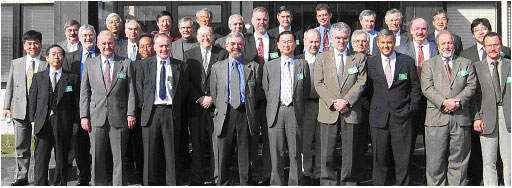
Fig. 1 W54 workshop participants from Japan, EU, US, Russia, and China (33 participants)
Another important highlight is a joint investigation of new plasma configuration named "Current Hole" discovered in JT-60 and JET. A workshop was held at JT-60 to understand this configuration as a possible operation scenario of tokamak.
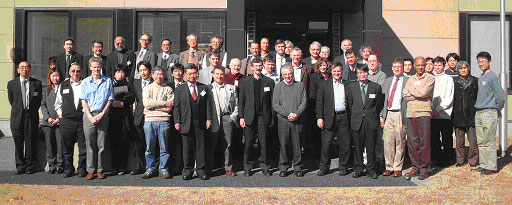
W56 workshop participants from Japan, EU and US(46 participants)
At the request of FPCC meeting on 30 January 2003, Executive Committee of IEA Large Tokamak cooperation decided to develop a Homepage of IEA large tokamak implementing agreement to increase our visibility to the public. Homepage address is http://www-jt60.naka.jaeri.go.jp/lt/.
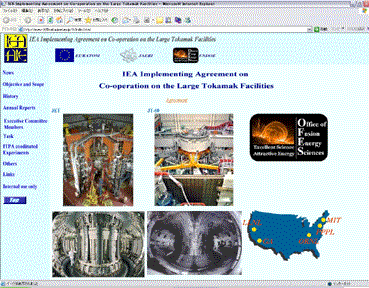
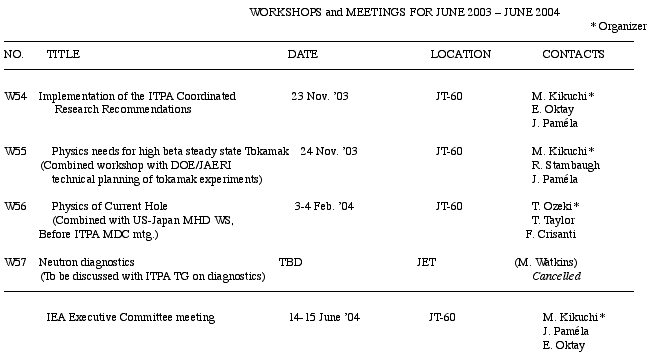
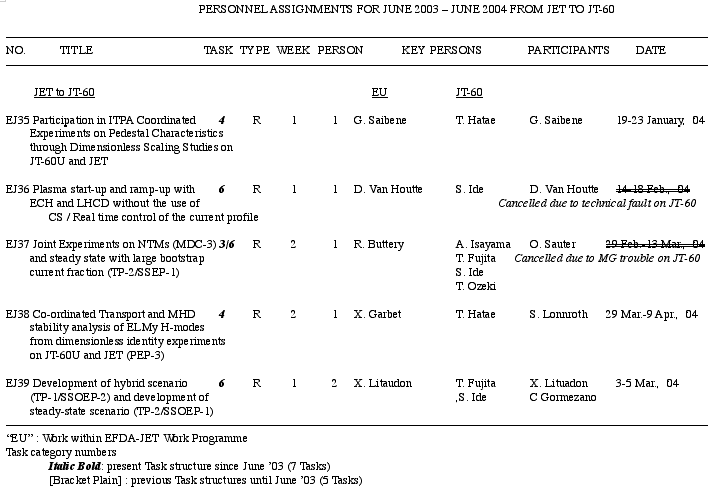
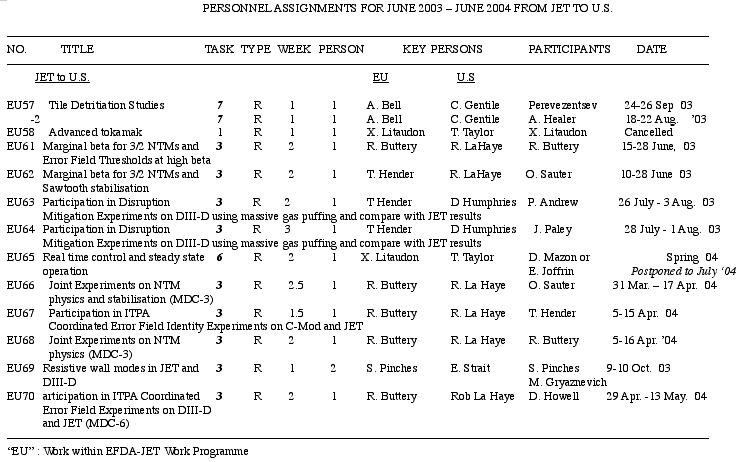
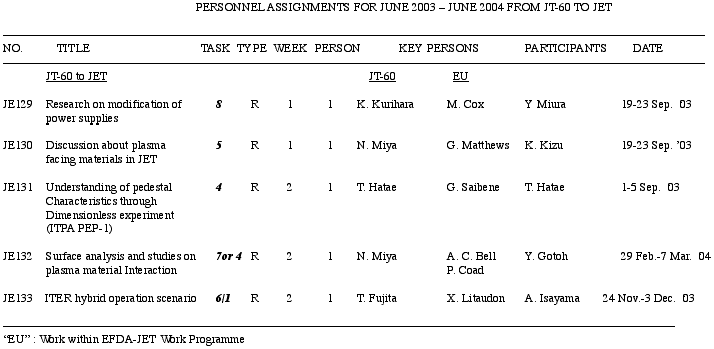

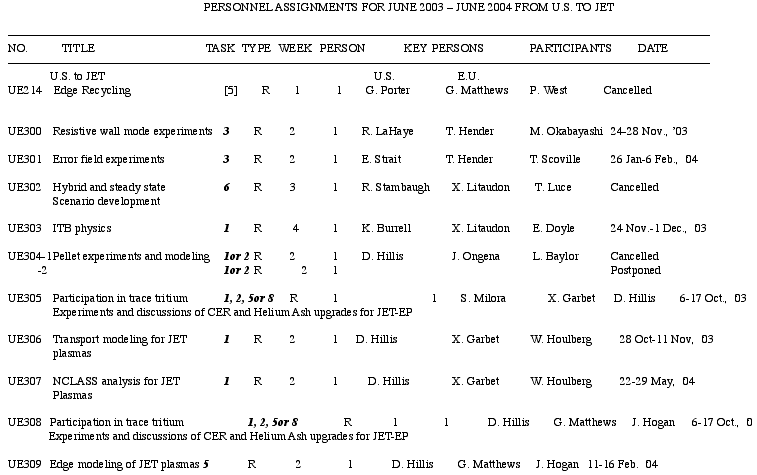
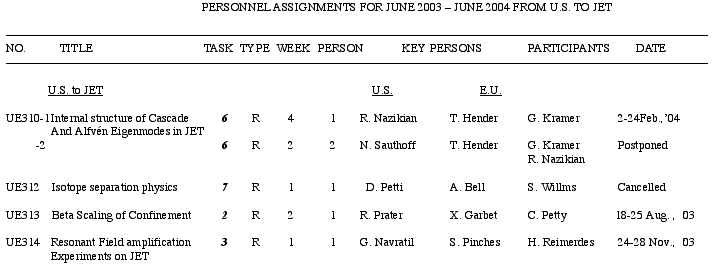
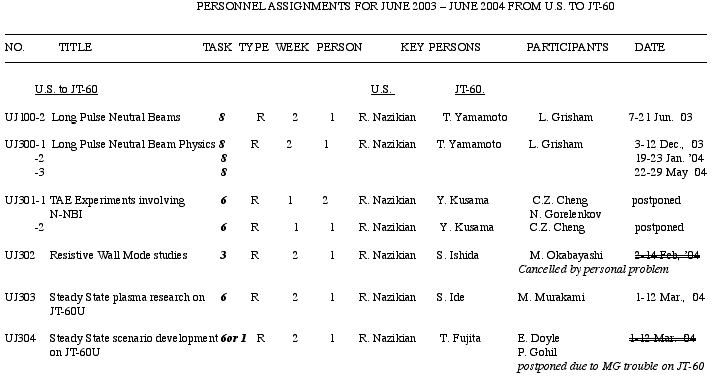
 -rays and by direct measurement of
-rays and by direct measurement of  particle confinement and thermalization. An ITER Q=10 reference scenario was demonstrated in JET.
particle confinement and thermalization. An ITER Q=10 reference scenario was demonstrated in JET. =1.9 was sustained for 24s , 2 times the current diffusion time. Advanced tokamak operation with high bootstrap current fraction fbs=75% was sustained for 7.4s and higher
=1.9 was sustained for 24s , 2 times the current diffusion time. Advanced tokamak operation with high bootstrap current fraction fbs=75% was sustained for 7.4s and higher  =3.0 was sustained for 6.2s.
=3.0 was sustained for 6.2s. * and n/nG as an appropriate dimensionless parameter in JET/C-Mod joint experiments indicates that confinement scales with
* and n/nG as an appropriate dimensionless parameter in JET/C-Mod joint experiments indicates that confinement scales with  * and not with n/nG. Dimensionless pedestal identity experiments between JT-60U and JET is also progressed showing existence of hidden parameter to explain the difference.
* and not with n/nG. Dimensionless pedestal identity experiments between JT-60U and JET is also progressed showing existence of hidden parameter to explain the difference. for m/n=3/2 and 2/1 modes has been studied in JET/DIII-D/AUG joint experiments. Effect of early ECCD injection on NTM was demonstrated in JT-60U and is planned in DIII-D. Sawtooth control to avoid NTM seeding was continued on JET/DIII-D/AUG/TCV while JT-60U NTM onset database are mainly without sawtooth. Effect of error field to reduce NTM onset
for m/n=3/2 and 2/1 modes has been studied in JET/DIII-D/AUG joint experiments. Effect of early ECCD injection on NTM was demonstrated in JT-60U and is planned in DIII-D. Sawtooth control to avoid NTM seeding was continued on JET/DIII-D/AUG/TCV while JT-60U NTM onset database are mainly without sawtooth. Effect of error field to reduce NTM onset  was studied in JET/DIII-D joint experiments indicating role of ion polarization current in NTM seeding. Joint experiments on effect of plasma rotation on RWM are progressed between JT-60U(having co-counter NBs) and DIII-D (planned to re-orient NB to counter). Mitigation of disruption forces and reduction of runaway current using noble gases in JT-60U(Kr+D2) and JET were also investigated.
was studied in JET/DIII-D joint experiments indicating role of ion polarization current in NTM seeding. Joint experiments on effect of plasma rotation on RWM are progressed between JT-60U(having co-counter NBs) and DIII-D (planned to re-orient NB to counter). Mitigation of disruption forces and reduction of runaway current using noble gases in JT-60U(Kr+D2) and JET were also investigated. * scan.
* scan. =1.9 was demonstrated in JT-60U while ITER hybrid scenario with qmin>1 has been tested in JET, DIII-D and AUG achieving required values of
=1.9 was demonstrated in JT-60U while ITER hybrid scenario with qmin>1 has been tested in JET, DIII-D and AUG achieving required values of 
 H89p/q952.
H89p/q952. hot JT-60U N-NB AE experiments to include effect of fast particles on AE mode structure.
hot JT-60U N-NB AE experiments to include effect of fast particles on AE mode structure.









